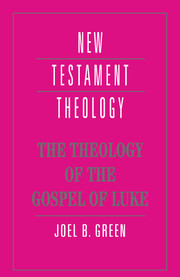Book contents
- Frontmatter
- Contents
- Editor's preface
- Preface
- List of abbreviations
- 1 “In the days of King Herod of Judea”: the world of Luke's Gospel
- 2 “God my Savior”: the purpose of God in Luke's Gospel
- 3 “A Savior, who is the Messiah, the Lord”: Jesus, John, and the Jewish people
- 4 “To proclaim good news to the poor”: mission and salvation
- 5 “Let them take up the cross daily”: the way of discipleship
- 6 “That you may know the truth”: Luke's Gospel in the church
- Further reading
- Index of biblical texts
- Index of modern authors
- Index of subjects
6 - “That you may know the truth”: Luke's Gospel in the church
Published online by Cambridge University Press: 05 June 2012
- Frontmatter
- Contents
- Editor's preface
- Preface
- List of abbreviations
- 1 “In the days of King Herod of Judea”: the world of Luke's Gospel
- 2 “God my Savior”: the purpose of God in Luke's Gospel
- 3 “A Savior, who is the Messiah, the Lord”: Jesus, John, and the Jewish people
- 4 “To proclaim good news to the poor”: mission and salvation
- 5 “Let them take up the cross daily”: the way of discipleship
- 6 “That you may know the truth”: Luke's Gospel in the church
- Further reading
- Index of biblical texts
- Index of modern authors
- Index of subjects
Summary
The influence of the Gospel of Luke in Western society is already striking. Musicians and artists of every era have returned to Luke's narrative of the nativity for images of divine–human encounter. Even in the rapidly emerging post- Christian society of the late twentieth century, people of all ages may still know something of the story that begins, “In the days of Caesar Augustus … “ (Luke 2:1). Many of the bestloved and most widely known stories of Jesus appear in the Third Gospel, but are absent in the Gospels of Matthew, Mark, and John. The Story of the Prodigal Son, the Story of the Good Samaritan, the Emmaus Road episode, Jesus' prayer from the cross, “Father, forgive them … “ (23:34) – these are a few of the peculiarly Lukan stories of Jesus known to and influential for both the Christian church and the wider public.
It must be acknowledged, though, that such examples as these point much more to the influence of Lukan material than to the influence of the Gospel of Luke as such. That is, these stories seem to have circulated in the church and world in, as it were, disembodied form, divorced from their narrative placement in the Third Gospel. This is a consequence, at least partially, of the atomistic way the Gospel has been read – or perhaps better, “mined” for nuggets of inspiration and truth. Not often in the history of Gospels' study has the Gospel of Luke been read “from left to right,” “from start to finish,” as a narrative whole. Already in the second century it was being employed as a repository from which one might draw information about Jesus.
- Type
- Chapter
- Information
- The Theology of the Gospel of Luke , pp. 122 - 152Publisher: Cambridge University PressPrint publication year: 1995



